A role for 5,6-epoxyeicosatrienoic acid in calcium entry by de novo conformational coupling in human platelets
- PMID: 16308346
- PMCID: PMC1464301
- DOI: 10.1113/jphysiol.2005.100800
A role for 5,6-epoxyeicosatrienoic acid in calcium entry by de novo conformational coupling in human platelets
Abstract
A major pathway for Ca(2+) entry in non-excitable cells is activated following depletion of intracellular Ca(2+) stores. A de novo conformational coupling between elements in the plasma membrane (PM) and Ca(2+) stores has been proposed as the most likely mechanism to activate this capacitative Ca(2+) entry (CCE) in several cell types, including platelets. Here we report that a cytochrome P450 metabolite, 5,6-EET, might be a component of the de novo conformational coupling in human platelets. In these cells, 5,6-EET induces divalent cation entry without having any detectable effect on Ca(2+) store depletion. 5,6-EET-induced Ca(2+) entry was sensitive to the CCE blockers 2-APB, lanthanum, SKF-96365 and nickel and impaired by incubation with anti-hTRPC1 antibody. Ca(2+) entry stimulated by low concentrations of thapsigargin, which selectively depletes the dense tubular system and induces EET production, was impaired by the cytochrome P450 inhibitor 17-ODYA, which has no effect on CCE mediated by depletion of the acidic stores using 2,5-di-(tert-butyl)-1,4-hydroquinone. We have found that 5,6-EET-induced Ca(2+) entry requires basal levels of H(2)O(2), which might maintain a redox state favourable for this event. Finally, our results indicate that 5,6-EET induces the activation of tyrosine kinase proteins and the reorganization of the actin cytoskeleton, which might provide a support for the transport of portions of the Ca(2+) store towards the PM to facilitate de novo coupling between IP(3)R type II and hTRPC1 detected by coimmunoprecipitation. We propose that the involvement of 5,6-EET in TG-induced coupling between IP(3)R type II and hTRPC1 and subsequently CCE is compatible with the de novo conformational coupling in human platelets.
Figures
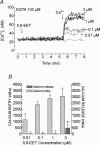


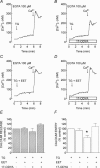
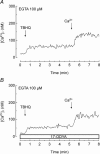
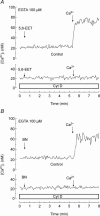


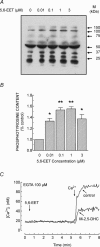

Similar articles
-
Functional relevance of the de novo coupling between hTRPC1 and type II IP3 receptor in store-operated Ca2+ entry in human platelets.Cell Signal. 2008 Apr;20(4):737-47. doi: 10.1016/j.cellsig.2007.12.010. Epub 2007 Dec 23. Cell Signal. 2008. PMID: 18249094
-
Dual role of tubulin-cytoskeleton in store-operated calcium entry in human platelets.Cell Signal. 2007 Oct;19(10):2147-54. doi: 10.1016/j.cellsig.2007.06.011. Epub 2007 Jun 28. Cell Signal. 2007. PMID: 17681754
-
A key role for reverse Na+/Ca2+ exchange influenced by the actin cytoskeleton in store-operated Ca2+ entry in human platelets: evidence against the de novo conformational coupling hypothesis.Cell Calcium. 2007 Dec;42(6):606-17. doi: 10.1016/j.ceca.2007.02.004. Epub 2007 Mar 23. Cell Calcium. 2007. PMID: 17383000
-
A role for the actin cytoskeleton in the initiation and maintenance of store-mediated calcium entry in human platelets.Trends Cardiovasc Med. 2000 Nov;10(8):327-32. doi: 10.1016/s1050-1738(01)00073-1. Trends Cardiovasc Med. 2000. PMID: 11369258 Review.
-
Store-operated Ca2+ entry: vesicle fusion or reversible trafficking and de novo conformational coupling?J Cell Physiol. 2005 Nov;205(2):262-9. doi: 10.1002/jcp.20399. J Cell Physiol. 2005. PMID: 15880447 Review.
Cited by
-
Integration of transient receptor potential canonical channels with lipids.Acta Physiol (Oxf). 2012 Feb;204(2):227-37. doi: 10.1111/j.1748-1716.2011.02311.x. Epub 2011 May 27. Acta Physiol (Oxf). 2012. PMID: 21624095 Free PMC article. Review.
-
Hydrogen peroxide activates calcium influx in human neutrophils.Mol Cell Biochem. 2008 Feb;309(1-2):151-6. doi: 10.1007/s11010-007-9653-9. Epub 2007 Nov 16. Mol Cell Biochem. 2008. PMID: 18008137
-
Inherited human group IVA cytosolic phospholipase A2 deficiency abolishes platelet, endothelial, and leucocyte eicosanoid generation.FASEB J. 2015 Nov;29(11):4568-78. doi: 10.1096/fj.15-275065. Epub 2015 Jul 16. FASEB J. 2015. PMID: 26183771 Free PMC article. Clinical Trial.
-
TRPC channel lipid specificity and mechanisms of lipid regulation.Cell Calcium. 2009 Jun;45(6):583-8. doi: 10.1016/j.ceca.2009.02.006. Epub 2009 Mar 25. Cell Calcium. 2009. PMID: 19324410 Free PMC article. Review.
-
Plasma and serum lipidomics of healthy white adults shows characteristic profiles by subjects' gender and age.PLoS One. 2014 Mar 14;9(3):e91806. doi: 10.1371/journal.pone.0091806. eCollection 2014. PLoS One. 2014. PMID: 24632803 Free PMC article.
References
-
- Alvarez DF, Gjerde EA, Townsley MI. Role of EETs in regulation of endothelial permeability in rat lung. Am J Physiol Lung Cell Mol Physiol. 2004;286:445–451. - PubMed
-
- Bergdhal A, Gómez MF, Dreja K, Xu SZ, Adner M, Beech DJ, Broman J, Hellstrand P, Sward K. Cholesterol depletion impairs vascular reactivity to endothelin-1 by reducing store-operated Ca2+ entry dependent on TRPC1. Circ Res. 2003;93:839–847. - PubMed
-
- Bird GS, Putney JW. Inhibition of thapsigargin-induced calcium entry by microinjected guanine nucleotide analogues. Evidence for the involvement of a small G-protein in capacitative calcium entry. J Biol Chem. 1993;268:21486–21488. - PubMed
Publication types
MeSH terms
Substances
LinkOut - more resources
Full Text Sources
Miscellaneous

